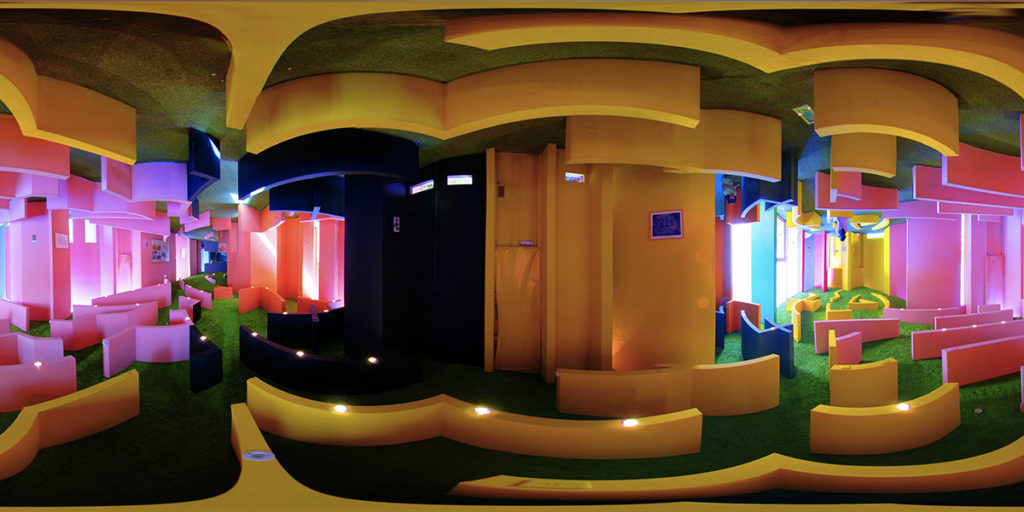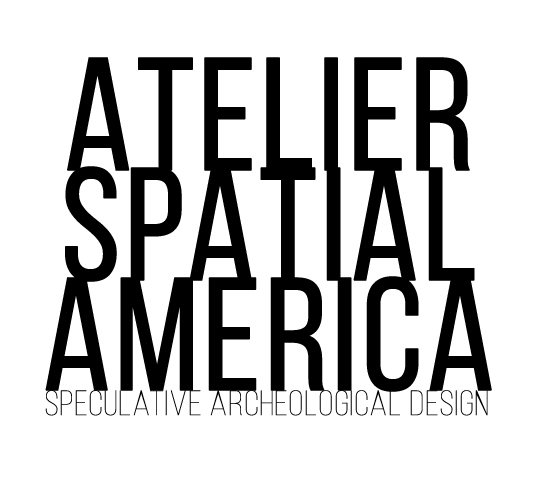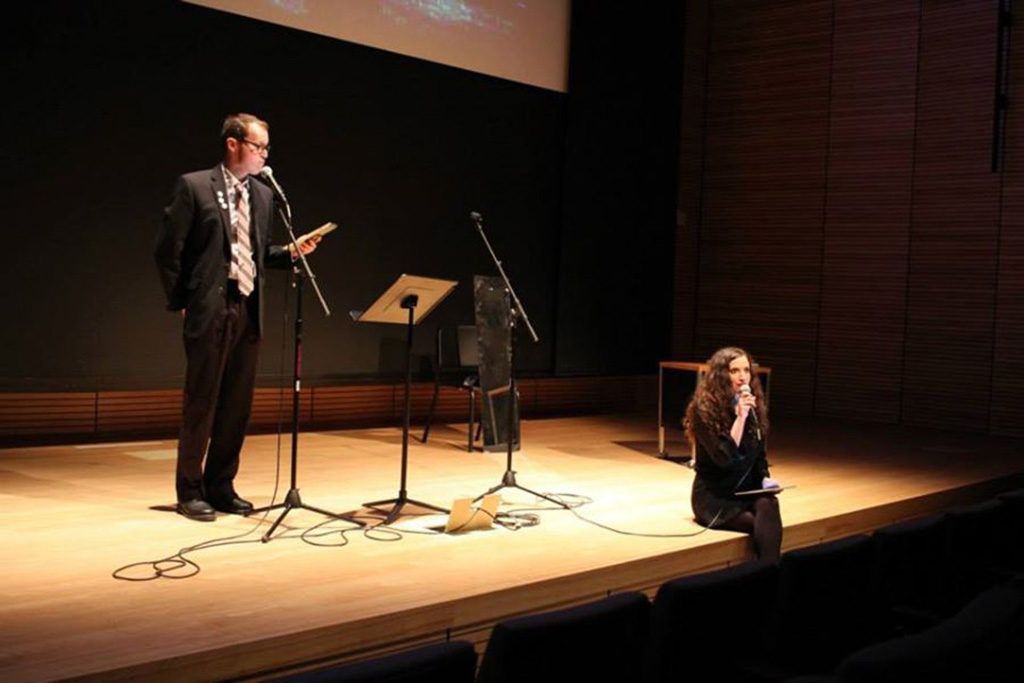by Atelier Spatial America (Claire Donato & Jeff T. Johnson)

Photo: Site of Reversible Destiny, Yoro Park, Gifu, Japan.
Adhering to a defeatist position, practitioners of every discipline, whether focused on figuring out life or on amusing or intriguing those who have life, stop before they ever reach the point of becoming radical, so convinced are they that we are destined to die.
— Madeline Gins and Arakawa, from Architectural Body

- With the spirit of Arakawa and Gins, we have decided not to die.
- Our decision not to die takes place in the wake of killing our project, Special America, a multimedia critical performance intervention that attempted to exercise and exorcise American exceptionalism in its local and global manifestations.
- Special America existed from 2008 to 2015. During this time, we labored to articulate our vision at digital arts conferences, poetry readings, and in classrooms. Successes were matched with failures. Our penultimate performance, at Babycastles in Manhattan, was a triumphant, fully choreographed stage show complete with song and dance and thirteen black helium balloons. Our final performance, at the infamous Brown University Interrupt 2015 conference one night before Kenneth Goldsmith presented his hideous, tone deaf “The Body of Michael Brown,” was the disaster from which we are reborn. The Special America production became fatally unwieldy, and the Interrupt performance collapsed under its own weight. All manner of technical glitch pervaded the performance, and any facility we had with the material abandoned us. Our script turned strange. The ominous Granoff Center whose fascist architecture we so gleefully skewered (we called it “a vision of horror that absorbed all passersby, drawing them into its vast, omni-surveillant eye-maw”) enacted its revenge on us. We were crushed on stage before a wall of half-empty seats, our pathetic slideshow frozen behind us, music cues gone rogue. It was a trial, and we were sentenced to death.
- Special America died on stage.
- The purgatory that immediately followed Special America’s Interrupt 2015 performance—the last performance of Special America as we had come to know it—was a time of weeping, screaming, and gnashing of teeth. First, we did so in semi-private, in the Granoff Center’s Green Room. Then we took our revolting display to the street, where Jeff hissed at Claire, who bit back. In despair, we resigned from the project and cried at Julian’s, which Google calls a “hip brewpub.”
- In between Special America’s final performance and the conception of Atelier Spatial America, which took three months to incubate, we meditated on the words of Maria Damon, who remarked in the halls of Granoff that Special America seemed on the verge of breaking out of its chrysalis to become something else.
- In these interstitial months of chrysalis-ing, we were evicted from our apartment of six years, Claire’s Saturn Return began, Jeff’s hair continued to grey, and we came to several important realizations: 1) performing Special America was no longer fun; 2) Special America performances left us wan and drained for days; and 3) Special America as we knew it was over.
- When we emerged from our chrysalis in late spring, following our first year of teaching in Pratt Institute’s Architecture Writing program, we discovered that we were becoming Spatial America. Indeed, we were already there.
- In the modern style, we embrace the conventional term atelier to describe our new practice—architects are great designers and wits, so we need not reinvent the spiel. Pre-existing discourse is the existing condition from which we build the future that is already here. As Wikipedia reveals, “Atelier is the French word for ‘workshop’; in English it is used primarily for the workshop of an artist in the fine or decorative arts, where a principal master and a number of assistants, students, and apprentices [work] together producing pieces released in the master’s name.” From henceforth, we shall refer to what will have been Special America as Atelier Spatial America.
- Atelier Spatial America is an experiment in reordering the body that was once Special America as much as it is an experiment in radical pedagogy and total access to architecture. Our intention is to perform the role of architect-designers as we collaborate with students and colleagues. We have no formal training in architecture or design, which is to our great advantage in reimagining the role of architecture and design. As an architectural body, we grant ourselves any and all necessary credentials and are therefore qualified to practice what we call Speculative Archeological Design (SAD).
- In the spirit of what was Special America, we are now accepting proposals. What should we design? Contact [email protected]. Please include as much detail as possible: diagrams, plans, models, written materials, documentation of process, etc. We are particularly interested in impractical visions, failed renderings, and unspeakable practices. We encourage you to repurpose your own (or others’) design work, artifacts, and presentation materials. We’ll sort it all out.
- We celebrate failed or unrealizable projects, freely remixing and reworking the pieces we collect.
- As we celebrate the failed works of others, we will speak with candor about our own failure. We will investigate what Special America was, and why it is no longer.
- “There is death and then there is death” (Arakawa & Gins).
- Architecture students design a future they seldom get to build. As Peggy Deamer remarks, “Studio work often operates on the unspoken assumption that the student must pretend that she is presenting a ‘building’ that is either phenomenally there in the room, or will quickly be built after the review is over. This pretense makes it difficult to admit, discuss, and analyze the status of the representation and to show that the only physical embodiment of the project is in the representations; the only life that it will have will be in the 30 minutes of its review presentation and then later in the portfolio” (“First Year: The Fictions of Studio Design” 5). We must save the future architecture students so meticulously create. Their visions will no longer go to waste. We have decided not to let them die.
- Free the project from the portfolio; release design from the studio. Liberate architecture from the death drive of discipline!
- Architectural design is multi-modal speech act: The proposal is the structure. We present the real. Or, to paraphrase Courtney Love, we fake it so real we are beyond fake. And to quote a fortune cookie from Atelier Spatial America’s first business lunch: Attitude is more important than facts.
- To quote the other fortune cookie from Atelier Spatial America’s first business lunch: Be patient! The Great Wall didn’t got built in one day.
- Atelier Spatial America will preserve, archive, and present materials related to the futures architecture students are uniquely capable of designing, thereby bringing them into being. This will help us all practice Speculative Archeological Design (SAD) as becoming-architecture.
- The future is past, and we must rediscover this future design. Existing diagrams, plans, models, and other materials related to architecture studio pinup presentations and reviews are the best evidence of SAD. We will sample, collect, and collate these resources for presentation in Atelier Spatial America performance lectures that serve as reports on our process of SAD becoming-architecture.
- Atelier Spatial America performance lectures will be structured in juried studio review format. All in attendance will be members of the jury, and will participate as they wish in what studio culture calls “crit.” Together we will redefine critical performance, while doing crit on the studio model of crit. In the spirit of our dearly departed Special America, we will unearth the community-driven exceptionalisms that drive studio culture, and bring to light new forms and relations.
- As critical performance and radically inclusive pedagogy, Atelier Spatial America recognizes and encourages three types of participation: contributive, responsive, and silent.
- Before its demise, Special America was planning to stage an intervention concerning the ultimate exceptionalism: the privileging of the human. Atelier Spatial America remains committed to dismantling this anthropocentrism. We are all animals, and we are all architects, so we build animal architecture.
- If we design it, we have to live with it.
- Architecture is ours and we must take it back.

Photo by John Cayley
BIOGRAPHY:
Atelier Spatial America is a speculative architecture and design firm that rose from the collapsed structure of Special America, a multimedia critical performance intervention that took place from 2008-2015, first incubated in the electronic literature community, then spread to the New York City Poetry Industrial Complex. Follow us on Twitter @spatialamerica.
PRINCIPALS:
Claire Donato is the author of the novel Burial (Tarpaulin Sky Press, 2013) and a full-length collection of poems, The Second Body (Poor Claudia, forthcoming 2016). Recent work has been published or is forthcoming in Ninth Letter, Aufgabe, Encyclopedia L-Z, BOMB, Black Warrior Review, and the Organism for Poetic Research’s PELT. She lives in Brooklyn, where she is at work on a second novel, Noël, and currently teaches as a Visiting Assistant Professor in the Architecture Writing and Creative Writing Programs at Pratt Institute. For more information, visit somanytumbleweeds.com.
Jeff T. Johnson is a digital artist and critic whose ARCHIVERSE project — an open-field concrete poem composed in AutoCAD — is documented at the Organism for Poetic Research. Recent work is forthcoming or has appeared in Jacket2, On Contemporary Practice, Encyclopedia L-Z, PEN America, and elsewhere. He lives in Brooklyn, where he is at work on a book entitled Trouble Songs: A Musicological Poetics, an investigation of the appearance of the word “trouble” in twentieth- and twenty-first-century music. He is a Visiting Assistant Professor in the Architecture Writing Program at Pratt Institute. For more information, visit jefftjohnson.com.